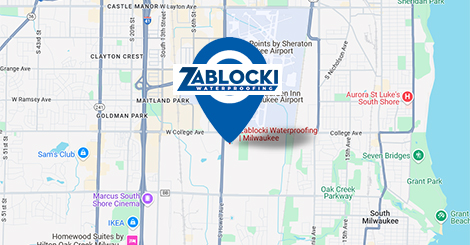Cleaning Up Your Basement After It’s Flooded
 Out of all the moisture issues Wisconsin homeowners must face, a flooded basement can be one of the most intimidating. Even such a small amount as a couple inches of water in your basement can cause immeasurable damage, so it’s important to take action as soon as possible to solve the problem and clean up the mess. Keep reading for some helpful tips for cleaning up your basement after it is flooded. Not sure what’s causing your flooding problem? The foundation repair and basement waterproofing experts at Zablocki Waterproofing can locate the source of your moisture issue.
Out of all the moisture issues Wisconsin homeowners must face, a flooded basement can be one of the most intimidating. Even such a small amount as a couple inches of water in your basement can cause immeasurable damage, so it’s important to take action as soon as possible to solve the problem and clean up the mess. Keep reading for some helpful tips for cleaning up your basement after it is flooded. Not sure what’s causing your flooding problem? The foundation repair and basement waterproofing experts at Zablocki Waterproofing can locate the source of your moisture issue.
Cleaning Up Your Basement After It’s Flooded
[grid_row_open class=””]
 Safety First
Safety First
First things first, stay safe during your cleanup efforts. The very first thing you want to do before you even venture into the affected area of your home or commercial building is to cut off that area’s electricity. We all know what happens when we combine water with electricity, so be sure to cut the power before you do anything else. The second thing you want to do before venturing into the depths of the structure is suit up. Even if the flood was caused by excessive rainwater, there’s no telling what sort of bacteria and other illness-inducing things could be floating around in that water. You can opt to wear whatever protective gear you find necessary, but we recommend waterproof boots and gloves at a minimum. Lastly, if possible, get some fresh air moving by opening up some doors and windows.[grid_row_close]
[grid_row_open class=””]
 Clear the Area
Clear the Area
Once you’re sure that there is no power being routed to the flooded area, it’s time to start actually flexing those muscles. Begin by removing all electronics and any other belongings you can. Then, move whatever furniture you can. The quicker you move your things out of the water, the more likely it is that you’ll be able to save some of your stuff. Be sure to remove all rugs, and if the flooded area is carpeted, that will also need to be removed. Do your best to have fun with this part. If you sort through all of your waterlogged stuff with a negative attitude, the rest of the cleanup will only be more stressful. [grid_row_close]
[grid_row_open class=””]
 Remove the Water
Remove the Water
The important thing here is to remove all standing water from your basement to prevent mold growth and other moisture problems. Depending on the amount of water you’re looking at, you may be okay with towels and mops, or you may need to rent a sump pump from your local hardware store. You may also opt to use a wet vacuum, but be cautious of where you plug it in, and avoid using extension cords. Either dump the water down the toilet if you have working plumbing, or dump it into other areas that will soak it up, such as your lawn. You may use the drains in your home, but hair other debris in the water may cause backup issues.[grid_row_close]
[grid_row_open class=””]
 Dry the Area
Dry the Area
If the flood affected any baseboards, drywall, subfloor, etc., you’ll want to remove this first to avoid mold growth. Once the basement has been cleared of all affected materials, it’s time to let it dry. You can use fans to speed up the process and open windows and doors. You may also opt to run a dehumidifier to limit the moisture in the air, but close the windows first, or you’ll be attempting to dehumidify all of Wisconsin. You may be disappointed to discover how much of your old building materials must be thrown out, but just think about all of the mold growth opportunities you’re eliminating.[grid_row_close]
[grid_row_open class=””]
 Disinfect the Area
Disinfect the Area
Standing water plays host to all manner of bacteria and other nasty things, so be sure to disinfect every single surface that was touched by the water, and we do mean with a powerful disinfectant and something to scrub with. Be sure to also scrub any furniture you’re planning on salvaging from the flood. Anything and everything you’re planning on keeping that had contact with the water should get a good scrub down.[grid_row_close]
[grid_row_open class=””]
 Sort Through Your Stuff
Sort Through Your Stuff
This part is never fun, but you’ll need to determine what can be saved and what needs to be thrown out. This will really depend on how much water was present in your basement and what types of belongings you had down there. Pillows, stuffed animals, and down blankets that have been soaked through should probably be thrown away while a blanket that only got a bit damp on one side can probably just go through the wash. Be sure to be responsible in the disposal of toxic chemicals, electronics, furniture, etc. Lastly, protect yourself from illness by not taking any chances. If something looks too waterlogged to be savable, then just throw it away.[grid_row_close]
We hope you never have to deal with flooding in your basement, but we hope these tips help you out if you do. Do you need foundation repair or basement waterproofing services in the Milwaukee area? Contact Zablocki Waterproofing, your leading foundation repair and waterproofing experts.



